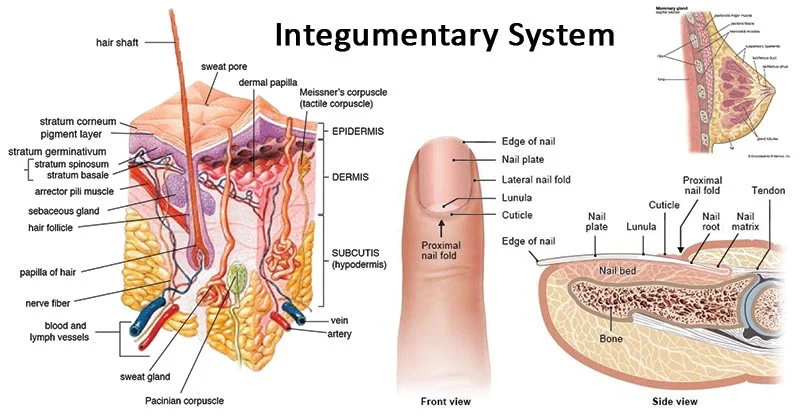
Integumentary System (Skin)
Integumentary System
- Introduction
The Integumentary System is the outer covering of our body. It mainly includes skin, hair, nails, sweat glands, and oil glands.
It acts like a shield that protects us from the outside world. Without this system, our body would be exposed to injuries, infections, and dehydration.
In simple way
👉 This is the body’s first line of defense and also the largest system of the body.
⸻
- Main Parts of the Integumentary System
(a) Skin
• The largest organ of our body.
• It covers about 1.5 to 2 square meters in adults.
• Average skin weight is about 3–4 kg.
• Made up of 3 layers:
1. Epidermis – Outer thin layer, protects from germs, dust, and water loss.
2. Dermis – Middle thick layer, contains blood vessels, nerves, sweat glands, and hair roots.
3. Hypodermis (Subcutaneous layer) – Inner fatty layer that stores fat and keeps the body warm.
⸻
(b) Hair
• Grows from hair follicles in the skin.
• Provides warmth and protects from dust and small particles.
• Eyelashes protect the eyes, while nasal hair filters air we breathe.
⸻
(c) Nails
• Made of a protein called keratin.
• Protects the tips of fingers and toes.
• Helps us in scratching, picking, and holding small objects.
⸻
(d) Sweat Glands
• Found in the dermis layer.
• Produce sweat which helps to:
• Cool the body during heat.
• Remove waste like salt and water.
⸻
(e) Sebaceous (Oil) Glands
• Produce sebum (oil) that keeps skin soft, flexible, and waterproof.
• Prevents dryness and cracks.
⸻
- Functions of the Integumentary System
- Protection – Stops germs, harmful UV rays, and injuries.
- Temperature Control – Sweat cools the body; fat layer keeps it warm.
- Sensation – Skin has nerves to feel touch, heat, cold, and pain.
- Excretion – Removes waste (like salts and water) through sweat.
- Vitamin D Production – Skin makes vitamin D when exposed to sunlight.
- Waterproofing – Stops water loss from body.
⸻
4. Interesting Facts About Skin ✨
• Skin renews itself every 28–30 days.
• An average adult has about 5 million hair follicles.
• Goosebumps happen when tiny muscles pull hair upright (usually when cold or scared).
• Fingerprints are unique – no two people in the world have the same fingerprint.
• The thickest skin is on the soles of feet and the thinnest is on eyelids.
⸻
5. Importance in Daily Life
• If our skin gets cut, germs can easily enter and cause infections.
• Proper skin care (washing, moisturizing, and protecting from sunburn) is very important.
• Diseases like acne, eczema, and skin cancer are related to this system.
⸻
📝 Conclusion
The Integumentary System is not just our outer covering but a life-saving shield. It protects, regulates temperature, and helps us feel the world through touch. Taking care of skin, hair, and nails is necessary for a healthy body.